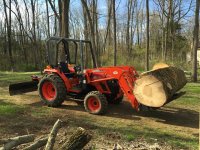Mike_Kanzer
Gold Member
- Joined
- Jul 14, 2005
- Messages
- 335
- Location
- Chester county, PA
- Tractor
- Kubota L3830 HST, JD Gator 855D
I normally put my bushhog on the back of my L3830 Kubota to use as ballast whem I am doing loader work. It weighs in around 500lbs. I have seen folks on TBN building concerete 3pt ballasts weighing in well over 1000lbs. It seems to me that there must be a point where the ballast works against the tractor. Clearly the ballast plus the load in the loader combine and limit what the tractor is capable of carrying. How would you figure out how much ballast to use so that it isn't working against you? I know it differs based on the size and weight of your tractor, but I would like to know what people think about it.
